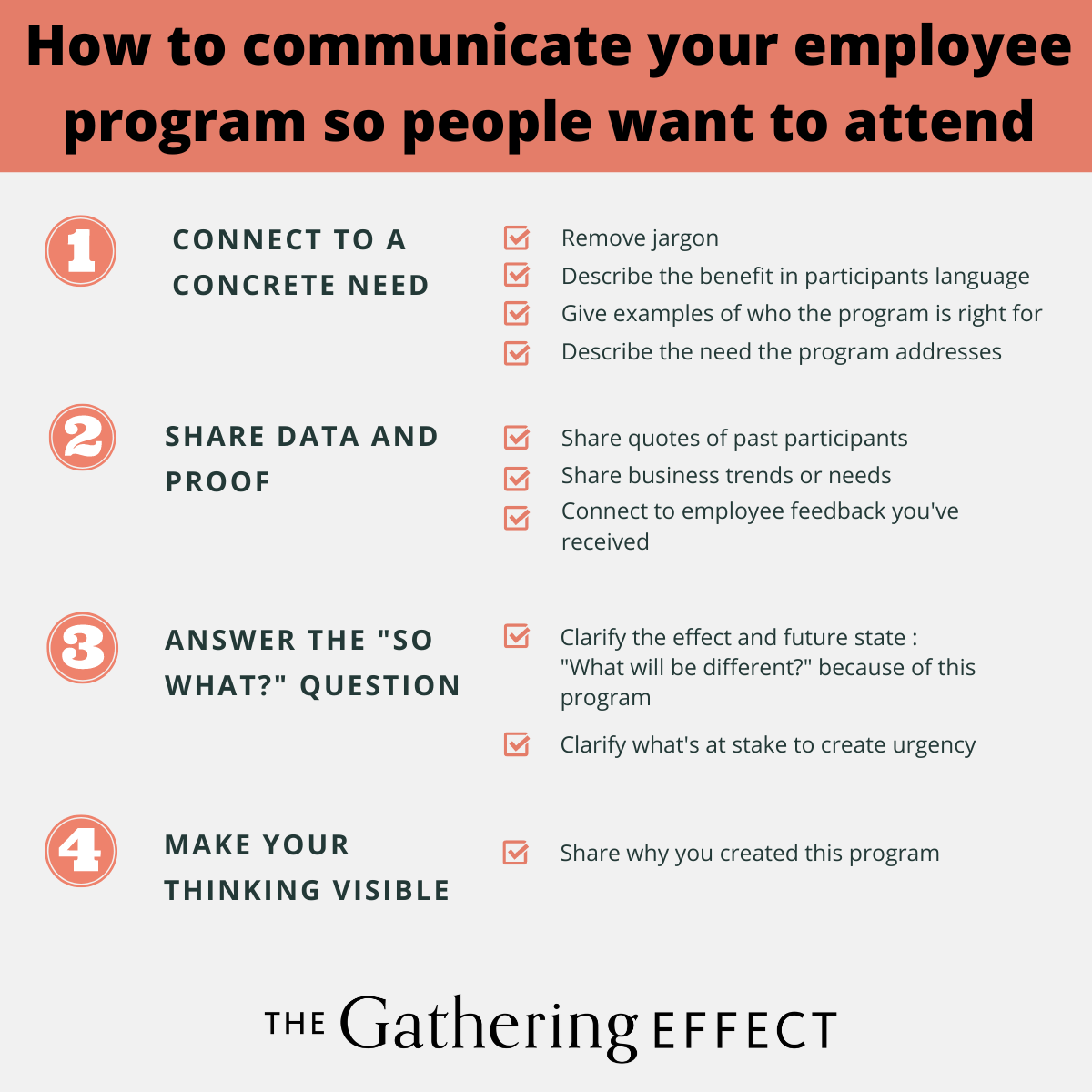5 ways to boost adoption and attendance
Despite our best efforts, getting buy-in and attendance for the programs and workshops we work so hard to deliver can be challenging. What accounts for this gap and how can we help close it?
In this blog, I’ll share my favorite strategies to drive adoption and attendance for your training classes, town halls, and employee programs and events without wildly changing the content, including:
Pre-workshop communication techniques
Influencing strategies before, during, and after workshops and employee events
The conditions that increase engagement with content
Why is attendance so challenging?
This is a dilemma I not only hear from clients and friends, but it’s also one I experienced myself as a Learning and Development leader.
We pour our hearts, time, budgets, efforts, etc into building programs, events, gatherings, and initiatives employees tell us they want and need.
Yet when it comes time for the event, its impact is lessened by low turnout. Understandably, we are left wondering why. Here’s what to try:
1. Ask and answer a central question
What is the mystery behind Lumon Industries? Who dies in White Lotus? Is love truly blind? These are the central questions of popular television shows Severance, The White Lotus, and Love is Blind. We tune into these shows and watch until the very end because we want the answer.
The same device used in entertainment can be applied in our employee programs. Tease your gathering with a central question you’ll be answering, such as: “What’s expected of you as a manager?”, “What are our top 3 priorities as a business?”.
Central questions use curiosity and surprise to drive attendance and adoption - not to trick people or set false expectations.
The Heath Brothers (authors of my favorite book on change, Switch) call this An Itch We Want to Scratch. What can we share that pulls us into wanting to know more and have our itch resolved?
2. Determine what’s at stake
“Part of Your World” from The Little Mermaid is more than a pleasant song. It’s an intentional device found in musicals (called an “I Want Song”) to help us understand and care about the main character’s motivation.
Fans of the television show Schitt’s Creek will recall learning the main characters lost all of their money and worldly possessions in the first episode, thus setting up their need to restart their lives in a new town. Because we know what’s at stake for these characters we are more inclined to tune in for the resolution.
Knowing and raising the stakes means understanding our employee’s problems that need solving. It’s a problem so important that it would drive an employee to attend and adopt our event or change program.
How to determine what’s at stake
Ask what’s at stake – If people are there by choice, they came for a reason. So, surface it. Ask, “What does this topic make you think about - what open questions do you have?” This is especially helpful at the start of your event.
Name what’s at stake — Stakes get raised not just with desire, but with data such as retention or attrition numbers, engagement surveys, revenue, or other business metrics. If nothing is at stake, or there isn’t a clear want, our initiatives run the risk of becoming check-the-box initiatives that people may comply with but not necessarily be engaged enough with to follow to the end. Calling out what is likely on people’s minds builds trust and helps others feel seen.
Plus, understanding motivation is more effective than manufacturing stakes - such as making your event mandatory.
3. Perfect your pre-communication
I define gathering as “bringing people together to match a message with the moment.” Too often, we focus on the message only. When that happens, there’s less of a reason for a synchronous gathering. “Can you just send me the slides?”. The answer is likely, “sure.”
It’s common for invites to be all about the message and less about the moment.
Consider the typical pre-gathering email that includes basic facts and a light agenda (message only):
“Tomorrow is our Town Hall. It starts at 4 pm. We will be joined by [insert name] to talk about [insert topic] followed by a discussion on our financials. Looking forward to it — see you there”.
Sure, attendees know what they’ll be listening to but it’s less clear why they should attend. Ensure your messages highlight what is unique about the moment as well:
“Tomorrow is our Town Hall. I’m very excited to see you all there. I rely on your feedback and contributions to tell me and our leaders what resonates and what we should do more of. This is the first time we’ll be sharing our Q4 financials and what it means for our growth plans. Thanks for clearing your schedules to attend — it means a lot that this is one time the whole company is together — even if it’s virtually.”
Ask yourself “What is unique about this moment”? Elevate your attendees to let them know they are necessary to the gathering’s success, by creating mutual accountability and a strong in-group.
For more pre-communication tips check out my communication checklist below
4. Create an A+ agenda
We want our agendas to do more than list topics. We want them to answer the “So WHAT?” question. This goes for agendas you include in calendar invites, emails, and also as slides in your presentation decks.
It’s common to communicate the agenda or the content of our gathering when what people need is clarity on the effect. Here’s an example of the difference:
Be able to ask and answer, what will be different because of our time together? This is one reason why sharing stories and testimonials is helpful - they give employees examples of what life can look like on the other side.
Instead of a list of sessions or topics, share the what, the how, and the why “Here’s what you’ll walk away with, here’s how we’re going to get there, and why this matters to you”
5. Give employees skin in the game
“You might taste notes of strawberry or crisp apple”. There is a reason why we learn about the tasting notes of wine when we sit down for a wine tasting. This gives us something to react to or discuss right from the start. It gives people skin in the game. We can leverage the same strategy with our employees.
Our opportunity is to find ways to give employees ownership or a role in the success of our program or event. This helps employees know why we need them there, elevates their status, and gives them agency.
You can do this by asking for their help or feedback especially if you are sharing something new, offering choice whenever possible (in the activity, the debrief question, or even the timing of the event). Or simply give them time to digest or talk with each other especially if it’s a content-heavy section.
These small choices help ensure our events and programs are being done with others instead of to them, thus engaging them in the process more fully and for longer.
Adoption and attendance don’t come from content alone. They come from helping people connect to the content. These five strategies help to create the conditions for more connection and ultimately, employee trust.
Lindsey Caplan is a screenwriter turned organizational psychologist who helps HR & business leaders create experiences that boost motivation, engagement, and performance



